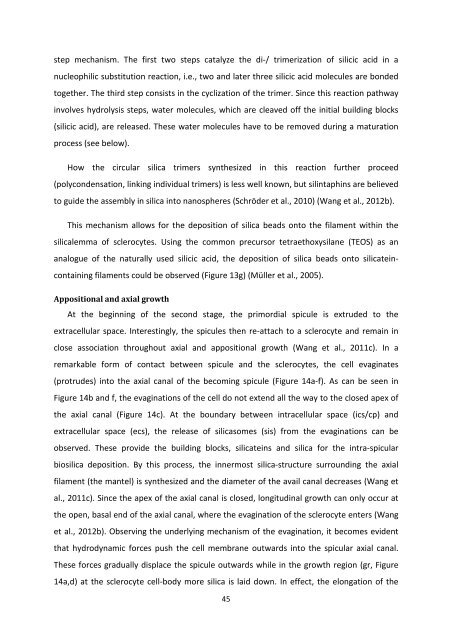MASTER THESIS Biomimetic potential of sponge ... - IAP/TU Wien
MASTER THESIS Biomimetic potential of sponge ... - IAP/TU Wien
MASTER THESIS Biomimetic potential of sponge ... - IAP/TU Wien
You also want an ePaper? Increase the reach of your titles
YUMPU automatically turns print PDFs into web optimized ePapers that Google loves.
step mechanism. The first two steps catalyze the di-/ trimerization <strong>of</strong> silicic acid in a<br />
nucleophilic substitution reaction, i.e., two and later three silicic acid molecules are bonded<br />
together. The third step consists in the cyclization <strong>of</strong> the trimer. Since this reaction pathway<br />
involves hydrolysis steps, water molecules, which are cleaved <strong>of</strong>f the initial building blocks<br />
(silicic acid), are released. These water molecules have to be removed during a maturation<br />
process (see below).<br />
How the circular silica trimers synthesized in this reaction further proceed<br />
(polycondensation, linking individual trimers) is less well known, but silintaphins are believed<br />
to guide the assembly in silica into nanospheres (Schröder et al., 2010) (Wang et al., 2012b).<br />
This mechanism allows for the deposition <strong>of</strong> silica beads onto the filament within the<br />
silicalemma <strong>of</strong> sclerocytes. Using the common precursor tetraethoxysilane (TEOS) as an<br />
analogue <strong>of</strong> the naturally used silicic acid, the deposition <strong>of</strong> silica beads onto silicateincontaining<br />
filaments could be observed (Figure 13g) (Müller et al., 2005).<br />
Appositional and axial growth<br />
At the beginning <strong>of</strong> the second stage, the primordial spicule is extruded to the<br />
extracellular space. Interestingly, the spicules then re-attach to a sclerocyte and remain in<br />
close association throughout axial and appositional growth (Wang et al., 2011c). In a<br />
remarkable form <strong>of</strong> contact between spicule and the sclerocytes, the cell evaginates<br />
(protrudes) into the axial canal <strong>of</strong> the becoming spicule (Figure 14a-f). As can be seen in<br />
Figure 14b and f, the evaginations <strong>of</strong> the cell do not extend all the way to the closed apex <strong>of</strong><br />
the axial canal (Figure 14c). At the boundary between intracellular space (ics/cp) and<br />
extracellular space (ecs), the release <strong>of</strong> silicasomes (sis) from the evaginations can be<br />
observed. These provide the building blocks, silicateins and silica for the intra-spicular<br />
biosilica deposition. By this process, the innermost silica-structure surrounding the axial<br />
filament (the mantel) is synthesized and the diameter <strong>of</strong> the avail canal decreases (Wang et<br />
al., 2011c). Since the apex <strong>of</strong> the axial canal is closed, longitudinal growth can only occur at<br />
the open, basal end <strong>of</strong> the axial canal, where the evagination <strong>of</strong> the sclerocyte enters (Wang<br />
et al., 2012b). Observing the underlying mechanism <strong>of</strong> the evagination, it becomes evident<br />
that hydrodynamic forces push the cell membrane outwards into the spicular axial canal.<br />
These forces gradually displace the spicule outwards while in the growth region (gr, Figure<br />
14a,d) at the sclerocyte cell-body more silica is laid down. In effect, the elongation <strong>of</strong> the<br />
45

















